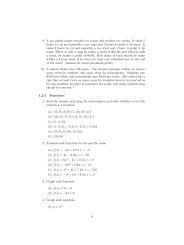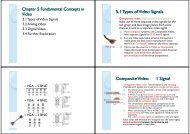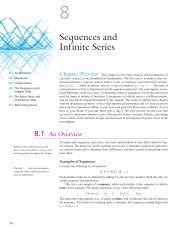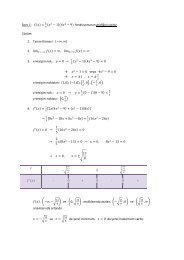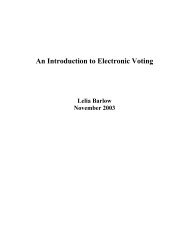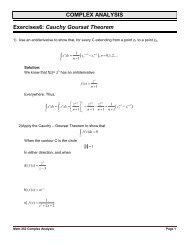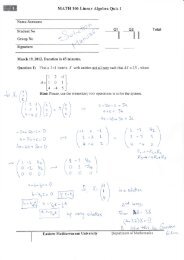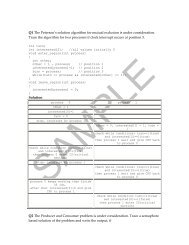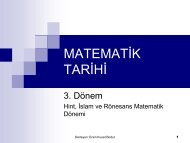Chapter6
Chapter6
Chapter6
Create successful ePaper yourself
Turn your PDF publications into a flip-book with our unique Google optimized e-Paper software.
Math 322 Probability and Statistical Methods<br />
Chapter 6 Continuous Probability Distributions<br />
The observations generated by different statistical experiments have the same general type of<br />
behavior. The followings are the probability distributions that will be covered in this chapter:<br />
• Continuous Uniform Distribution<br />
• Normal Distribution<br />
• Normal Approximation to Binomial Distribution<br />
• Gamma and Exponential Distribution<br />
• Chi-Squared Distribution<br />
The Continuous Uniform Distribution<br />
One of the simplest continuous distributions in all statistics is the continuous uniform<br />
distribution. This distribution is characterized as follows:<br />
Definition. The density function of the continuous random variable X on the interval [ A, B ] is<br />
⎧ 1<br />
⎪ , A ≤ x ≤ B<br />
f ( x; A, B) = ⎨ B − A<br />
⎪<br />
⎩0,<br />
elsewhere.<br />
Theorem. The mean and variance of the continuous uniform distribution are<br />
( ) 2<br />
A + B<br />
B − A<br />
2<br />
μμμμ = and σσσσ = .<br />
2<br />
12<br />
1<br />
Sonuc Zorlu Lecture Notes
Math 322 Probability and Statistical Methods<br />
The Normal Distribution<br />
The most important continuous probability distribution in the entire field of statistics is the<br />
normal distribution. Normal distributions are a family of distributions that have the same general<br />
shape. They are symmetric with scores more concentrated in the middle than in the tails. Normal<br />
distributions are sometimes described as bell shaped which are shown below. Notice that they<br />
differ in how spread out they are. The area under each curve is the same. The height of a normal<br />
distribution can be specified mathematically in terms of two parameters: the mean (µ) and the<br />
standard deviation (σ).<br />
Definition. The density function of the normal random variable X , with mean μμμμ and variance<br />
2<br />
σσσσ , is<br />
where ππππ = 3.14159.... and e = 2.71828 .<br />
Standard normal distribution<br />
2<br />
1 −( 1/ 2 ) ⎡⎣ ( x−μμ<br />
μμ ) / σσ<br />
σσ<br />
⎤⎦<br />
N ( x; μμ μμ , σσ<br />
σσ<br />
) = e , − ∞ < x < ∞<br />
2πσ<br />
πσ πσ πσ<br />
The standard normal distribution is a normal distribution with a mean of 0 and a standard<br />
deviation of 1. Normal distributions can be transformed to standard normal distributions by the<br />
formula:<br />
where X is a score from the original normal distribution, µ is the mean of the original normal<br />
distribution, and σ is the standard deviation of original normal distribution. The standard normal<br />
distribution is sometimes called the z distribution. A z score always reflects the number of<br />
standard deviations above or below the mean a particular score is. For instance, if a person<br />
scored a 70 on a test with a mean of 50 and a standard deviation of 10, then they scored 2<br />
standard deviations above the mean. Converting the test scores to z scores, an X of 70 would be:<br />
2<br />
Sonuc Zorlu Lecture Notes
Math 322 Probability and Statistical Methods<br />
So, a z score of 2 means the original score was 2 standard deviations above the mean. Note that<br />
the z distribution will only be a normal distribution if the original distribution (X) is normal.<br />
Note : The following figures give us the areas to the right of some z − value, to the left of some<br />
z − value and between two z − values.<br />
Areas under portions of the standard normal distribution are shown to the right. About .68 (.34 +<br />
.34) of the distribution is between -1 and 1 while about .96 of the distribution is between -2 and<br />
2.<br />
3<br />
Sonuc Zorlu Lecture Notes
Math 322 Probability and Statistical Methods<br />
Example 1. Given a standard normal distribution, find the area under the curve that lies<br />
(a) to the right of z = 1.84<br />
(b) between z = − 1.97 and z = 0.86<br />
Solution. (a) P ( Z ) P ( Z )<br />
by table A3<br />
> 1.84 = 1− ≤ 1.84 = 1− 0.9671 = 0.0329 .<br />
(b) P ( Z ) P ( Z ) P ( Z )<br />
by table A3<br />
− 1.97 < < 0.86 = < 0.86 − < − 1.97 = 0.8051− 0.0244 = 0.7807<br />
Example 2. Given a normal distribution with μμμμ = 50 and σσσσ = 10 , find the probability that<br />
X assumes a value between 45 and 62.<br />
Solution.<br />
⎛ 45 − 50 62 − 50 ⎞<br />
P ( 45 < X < 62) = P⎜ < Z < ⎟ = P ( − 0.5 < Z < 1.2 ) = table(1.2) − table(<br />
−0.5)<br />
⎝ 10 10 ⎠<br />
= 0.8849-0.3088 = 0.5764<br />
Example 3. Given a standard normal distribution, find the value of k such that<br />
(a) P( Z < k ) = 0.0427<br />
(b) P ( Z > k ) = 0.2946<br />
(c) P ( Z k )<br />
− 0.93 < < = 0.7235<br />
Solution. (a) P ( Z < k ) = 0.0427 ⇒ table( k) = 0.0427 ⇒ k = − 1.72<br />
(b)<br />
(c) ( )<br />
( ) ( ) ( )<br />
⇒ P ( Z ≤ k ) = 1− 0.2946 = 0.7054<br />
P Z > k = 0.2946 ⇒ P Z > k = 1− P Z ≤ k = 0.2946<br />
⇒ table( k) = 0.7054 ⇒ k = 0.54<br />
P − 0.93 < Z < k = 0.7235 ⇒ table( k) − table(<br />
− 0.93) = 0.7235<br />
table( k)<br />
= 0.7235 + 0.1762 = 0.8997<br />
⇒ k = 1.28<br />
Example 4. Given the normally distributed random variable X with μμμμ X = 18 and<br />
(a) Compute P ( X > 13.74)<br />
(b) Compute x satisfying P ( x X )<br />
< < 18 = 0.4332 .<br />
σσσσ = 3<br />
4<br />
Sonuc Zorlu Lecture Notes<br />
2<br />
X
Math 322 Probability and Statistical Methods<br />
Applications of the normal Distribution<br />
Example 1. A certain machine makes electrical resistors having a mean resistance of 40 ohms<br />
and a standard deviation of 2 ohms. Assuming that the resistamce follows a normal distribution<br />
and can be measured to any degree of accuracy, what percenatge of resistors wil have a<br />
resistance exceeding 43 ohms?<br />
Solution. Let X be the normal random variable, given μμ μμ = 40 ohms, σσ<br />
σσ<br />
= 2ohms<br />
,<br />
⎛ X − μμμμ 43 − 40 ⎞<br />
P ( X > 43) = P ⎜ > ⎟ = P ( Z > 1.5) = 1− P ( Z ≤ 1.5)<br />
⎝ σσσσ 2 ⎠<br />
= 1 − table(1.5)<br />
= 1− 0.9332 = 0.0668 = 6.68%<br />
Example 2. The average grade for a exam is 74 and the standard deviation is 7. Assuming that<br />
the grades follow a normal distribution, what is the probability that a student will get grade of at<br />
least 60?<br />
Normal Approximation to Binomial Distribution<br />
2<br />
Theorem. If X is a binomial random variable with mean μμμμ = np and σσσσ = npq , then the<br />
limiting form of distribution of<br />
X bin − np<br />
Z = as n → ∞<br />
npq<br />
is the standard normal distribution N ( 0,1)<br />
.<br />
Note. We use the normal approximation to binomial distribution whenever p is not close to 0<br />
and 1. If both np and nq are greater than or equal to 5, the approximation will be good.<br />
Example 1. The probability that a patient recovers from a blood disease is 0.4. If 100 people are<br />
known to have contracted this disease what is the probability that less than 30 survive?<br />
Solution. Let X be the number of surviving people from blood disease.<br />
Given n = 100 and p = 0.40 , μμμμ = np = 100*0.40 = 40 , σσσσ = 100 * 0.40 * 0.60 = 0.24 ,<br />
⎛ X − np 29.5 − 40 ⎞<br />
P ( X bin < 30) ≈ P ( X nor < 29.5) = P⎜ < = P ( Z < − 2.14 ) = table(<br />
− 2.14) = 0.0162<br />
⎜<br />
⎟<br />
npq 24 ⎟<br />
⎝ ⎠<br />
5<br />
Sonuc Zorlu Lecture Notes
Math 322 Probability and Statistical Methods<br />
6<br />
Sonuc Zorlu Lecture Notes
Math 322 Probability and Statistical Methods<br />
Example 2. A coin is tossed 400 times, use the normal approximation to binomial to find the<br />
probability of obtaining<br />
(a) between 185 and 210 heads inclusive<br />
(b) exactly 205 heads<br />
(c) less than 176 or more than 227 heads<br />
Example 3. A ablanced die is rolled 180 times. Let be the number of cases when die shows the<br />
number 4 on its top face.<br />
(a) Find μμμμ X<br />
(b) Find<br />
2<br />
σσσσ X<br />
(c) Use normal approximation to binomial to approximate P ( 35 X 40)<br />
Exercises<br />
≤ ≤ .<br />
Exercise1. If scores are normally distributed with a mean of 30 and a standard deviation of<br />
5, what percent of the scores is: (a) greater than 30? (b) greater than 37? (c) between 28 and<br />
34?<br />
Exercise 2. Assume a normal distribution with a mean of 90 and a standard deviation of 7.<br />
What limits would include the middle 65% of the cases?<br />
Exercise 3. If is the standard normal random variable,<br />
P − 1.3 < Z < 1.37<br />
(a) Calculate ( )<br />
(b) If P ( a Z 1.12) 0.6845<br />
< < = , find the value of a .<br />
Exercise 4. A research scientists reports that mice will live an average of 40 months when<br />
their diets are sharply restricted and enriched with vitamins and proteins. Assuming that the<br />
lifetimes of such mice are normally distributed with a standard deviation of 6.3 months, find<br />
the probability that a given mouse will live<br />
(a) more than 32 months<br />
(b) less than 28 months<br />
(c) between 37 and 49 months.<br />
7<br />
Sonuc Zorlu Lecture Notes
Math 322 Probability and Statistical Methods<br />
Exponential and Gamma Distributions<br />
Another continuous distribution that has many useful applications is the exponential distribution,<br />
which has density<br />
( )<br />
f x<br />
⎧ 1 −x<br />
/ ββββ<br />
⎪ e , x > 0<br />
= ⎨ ββββ<br />
⎪⎩ 0, elsewhere<br />
Because the sample space for this distribution consists of the positive real numbers, this<br />
distribution is sometimes used to model time to failure or survival time of a system. The<br />
distribution function is,<br />
x<br />
1 −t / ββ ββ −x<br />
/ ββ<br />
ββ<br />
F( x) = ∫ e dt = 1 − e , x > 0<br />
ββββ<br />
−∞<br />
The exponential distribution has a special property that is unique to this distribution. Suppose<br />
that T is the time to failure of a randomly selected new component, and suppose that this r.v. has<br />
an exponential distribution with parameter ββββ . The probability that this new component survives<br />
to time t is,<br />
−t<br />
/<br />
( > ) = 1−<br />
( ) =<br />
P T t F t e<br />
A generalization of the exponential distribution that can provide a much wider range of models is<br />
f t; αα αα , β ββ<br />
β by<br />
based on the gamma integral. Define a function ( )<br />
⎧ 1 αα αα −1 −x<br />
/ ββ<br />
ββ<br />
⎪ x e , x ≥ 0<br />
αααα<br />
= ⎨Γ αα αα ββ<br />
ββ<br />
⎪⎩ 0, otherwise<br />
( ; αα αα , ββ<br />
ββ<br />
) ( )<br />
f x<br />
where αα αα , β ββ<br />
β are positive constants. Note that in this parameterizaton, the parameter ββββ is in the<br />
denominator of the exponential component. The reason for this modification will be shown<br />
below. Recall that<br />
which implies that<br />
and hence that f ( x; αα α, ββ<br />
β )<br />
∞<br />
αα αα −1 −t<br />
/ ββ ββ αα<br />
αα<br />
t e dt<br />
∫<br />
0<br />
∞<br />
∫<br />
0<br />
( αα αα ββ<br />
ββ<br />
)<br />
8<br />
Sonuc Zorlu Lecture Notes<br />
( )<br />
= ββ ββ Γ αα<br />
αα<br />
f t; , dt = 1<br />
α β is a density function. This density function defines a distribution on<br />
the positive real numbers and is referred to as the gamma distribution. Note that the<br />
exponential distribution is a special case of the gamma distribution in whichαααα = 1.<br />
The<br />
parameter αααα is referred to as the shape parameter and ββββ is referred to as the scale parameter of<br />
the gamma distribution.<br />
ββββ
Math 322 Probability and Statistical Methods<br />
Theorem. The Mean and Variance of the Gamma Distribution are<br />
2 2<br />
μμ μμ = αβ αβ αβ αβ and σσ σσ = αβ αβ αβ αβ<br />
Theorem. The Mean and Variance of the Exponential Distribution are<br />
2 2<br />
μμ μμ = ββ<br />
ββ<br />
and σσ σσ = ββ<br />
ββ<br />
The following is the plot of the gamma probability density function.<br />
Example 1. In a certain city the daily consumption of water (in millions of liters) follows a<br />
gamma distribution with αααα = 2 and ββββ = 3 .If the daily capacity of that city is 9 million liters of<br />
water, what is the probability that on a given day the water supply will be inadequate?<br />
Solution. Let X be the water supply in millions of liters of water. Given αααα = 2 and ββββ = 3 ,<br />
Thus, ( 9)<br />
∞<br />
⎧ 1 −x<br />
/ 3<br />
⎪ xe , x > 0<br />
2<br />
P( X > 9)<br />
= ∫ f ( x) dx where f ( x)<br />
= ⎨Γ ( 2) 3<br />
9<br />
⎪⎩ 0, otherwise<br />
∞<br />
− x / 3<br />
P X xe dx<br />
1 1<br />
> = ∫ = . 3<br />
9 e<br />
9<br />
Note. There is a relationship between the Exponential and Poisson distributions. Suppose events<br />
are occurring in time according to Poisson distribution with a rate of λλλλ events per hour. Thus in<br />
t hours, the number of events say Y , will have a Poisson distribution with mean value λλλλ t .<br />
9<br />
Sonuc Zorlu Lecture Notes
Math 322 Probability and Statistical Methods<br />
10<br />
Sonuc Zorlu Lecture Notes
Math 322 Probability and Statistical Methods<br />
Suppose we start at time zero and ask the question ‘How long do I have to wait to see the first<br />
event occur?’. Let X denote the length of time until the first event. Then<br />
and<br />
( ) ( )<br />
( ) 0<br />
> = = 0 int (0, )<br />
−λλλλ<br />
t<br />
λλλλ t e<br />
P X t P Y on the erval t<br />
= = e<br />
0!<br />
11<br />
Sonuc Zorlu Lecture Notes<br />
−λλλλ<br />
t<br />
( ) ( )<br />
t<br />
P X t 1 P X t 1 e λλλλ −<br />
≤ = − > = − .<br />
Thus,<br />
P X ≤ t = F t , the distribution function for X has the form of an exponential distribution<br />
( ) ( )<br />
1<br />
with λλλλ = (the failure rate). Upon differentiating, we see that<br />
ββββ<br />
−λλλλ<br />
t ( 1− ) 1 −t<br />
/<br />
d e<br />
ββββ<br />
f ( t) = = e , t > 0 .<br />
dt ββββ<br />
Example 2. The life of a certain type of device has an advertised rate of 0.01 per hour. The<br />
failure rate is constant and the exponential dsitribution applies.<br />
(a) What is the probability that 200-hours will pass before a failure is observed?<br />
−0.01x<br />
⎧ 0.01 e , x > 0<br />
Solution. Given f ( x)<br />
= ⎨ ,<br />
⎩0,<br />
otherwise<br />
−0.01x −0.01x ∞ −2<br />
( > ) = = − =<br />
∫<br />
P X 200 0.01 e dx e e .<br />
200<br />
(b) What is the mean time to failure?<br />
Solution. Since the failure rate 1<br />
= 0.01, μμ μμ = ββ<br />
ββ<br />
= 100 . Therefore the mean failure time is<br />
ββββ<br />
100-hours.<br />
Example 3. The length of time for one individual to be served at a cafeteria is a random variable<br />
having an exponential distribution with a mean of 4-minutes. What is the probability that a<br />
person is served is less than 3-minutes on at least 4 of the next 6 days?<br />
Example 4. The exponential distribution is frequently applied to the waiting times between<br />
successes in a Poisson process. If the number of calls received per hour by a telephone answering<br />
service is a Poisson random variable with parameter λλλλ = 6 , we know that the time, in hours,<br />
1<br />
between successive calls has an exponential distribution with parameter ββββ = . What is the<br />
6<br />
probability of waiting more than 15 minutes between any two successive calls?<br />
Example 5. In a certain city, the daily consumption of electric power in millions of kw-hours is a<br />
2<br />
random variable X having a Gamma distribution with μμμμ = 6 and σσσσ = 12 .
Math 322 Probability and Statistical Methods<br />
(a) Find the values of αααα and ββββ .<br />
μμ μμ = αβ αβ αβ αβ = 6 ⎫<br />
ββ ββ 2, αα<br />
αα<br />
3<br />
2 2 ⎬ ⇒ = = .<br />
σσ σσ = αβ αβ αβ αβ = 12 = 6.2⎭<br />
(b) Find the probability that on any given day the daily power consumption will exceed 12<br />
million kw-hours.<br />
∞ ∞<br />
1 −x / 2 2 1 − x / 2 2<br />
P ( X > 12)<br />
= ∫ e x dx = e x dx<br />
3<br />
12 2 Γ(<br />
3)<br />
16∫<br />
12<br />
Chi-Squared Distribution<br />
Another very important special case of the Gamma distribution is obtained by letting αα αα = υυ<br />
υυ<br />
/ 2<br />
and ββββ = 2 , where υυυυ is a positive integer. The result is called the Chi-squared distribution. The<br />
distribution has a single parameter, υυυυ , called the degrees of freedom.<br />
Definition. The continuous random variable X has a Chi-squared distribution, with υυυυ degrees<br />
of freedom, if its densityfunctionis given by<br />
⎧ 1 υυυυ / 2−1 − x / 2<br />
⎪<br />
x e , x > 0<br />
υυυυ / 2<br />
f ( x)<br />
= ⎨2 Γ(<br />
υυυυ / 2 )<br />
⎪⎩ 0, elsewhere<br />
where υυυυ is a positive integer.<br />
The Chi-squared distribution plays a vital role in stsatistical inference that will be studied in the<br />
next chapter. Topics dealing with sampling distributions, analysis of variance, and nonparametric<br />
statistics involve extensive use of the Chi-squared distribution.<br />
Theorem. The mean and variance of the Chi-squared distribution are<br />
2<br />
μμ μμ = υυ<br />
υυ<br />
and σσ σσ = 2υυ<br />
υυ<br />
.<br />
12<br />
Sonuc Zorlu Lecture Notes



